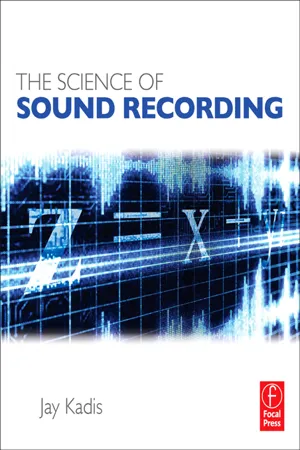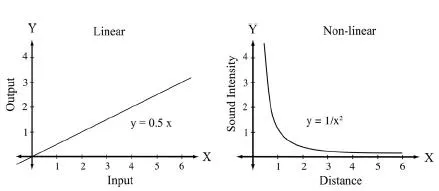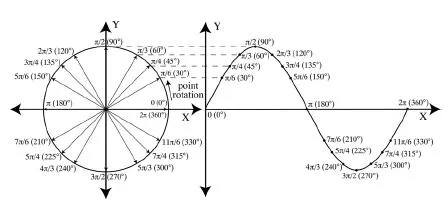![]()
CHAPTER ONE
Mathematics and the Measurement of Sound
Contents
Mathematics
Sinusoids
Logarithms and Exponents
Vectors
Polar Coordinates
Complex Numbers
Calculus
Statistics
Units of Measure
Sound is inherently a transient phenomenon. Natural sounds fade quickly, and we can’t just bottle up the air as it vibrates with sound waves and expect to hear the sounds again when we open the bottle. Although this behavior keeps the world from becoming a total cacophony, it also complicates the process of recording sounds. We need a method of converting such air vibrations into a form of energy that we can preserve over time. Metrology, the science of measurement, is a most important consideration in the recording of sound. To record and manipulate audio signals, we must first measure characteristics of the sound – generally pressure amplitude as a function of time – and in some manner preserve those measurements. Analog magnetic tape stores a continuous magnetic pattern representation of the measured signal. Digital audio systems store the signal as a list of discrete measurements at regular times that can then be treated like any other computer data. Because these measurements are a function of time, we must have a way of measuring time as well. Once we have a reliable record of time and the signal amplitude is stored, we can manipulate the signal electronically as analog audio or numerically as digital audio and then make changes to suit our artistic desires; we can process and mix sounds into sonic landscapes that never before existed. Appreciating that the quality of a recording depends on how well we are able to make a measurement is an important first step in the study of sound recording.
A measurement is an attempt to determine the value of a quantity using some form of calibrated tool or procedure. The number we obtain from our measurement should be exactly equal to the true value of the quantity under measure, a quality we refer to as accuracy. The tools available will ultimately determine the accuracy of measurements because there is always a limit to their resolution – that is, their ability to distinguish between two close values. When dealing with calculations, we must also be careful that we do not generate a false increase in accuracy simply through mathematical processing of the data. For example, if we make a measurement accurate to two decimal places, multiplying that value on a computer may result in a 15-decimal-place answer, but it is still accurate only to the two decimal places of our original measurement. A second term related to measurement quality is precision, a measure of how closely that measurement can be replicated in repeated attempts. These two terms are sometimes used synonymously but in fact have slightly different meanings.
MATHEMATICS
To study the recording process in an organized way, we should first familiarize ourselves with the tools involved in the investigation. We are interested in the processes that allow the permanent storage of information contained in the transient air pressure variations we call sound. Because sound recording involves acoustics, mechanics, electronics, magnetism, and ultimately physiology and psychology, we need to employ the tools of science. Because we are concerned initially with measurements of the behavior of air pressures, electronic signals, and magnetism, physics is the branch of science that will help develop our understanding of these systems, and mathematics is the descriptive language used by physicists. It turns out that similar mathematical descriptions apply to electronics, acoustics, and mechanics, so understanding what equations mean will help us explain the fundamental principles of sound recording.
When we want to see how two quantities are related, we can plot a graph comparing pairs of values termed variables. The variable we set by choosing its value is called the independent variable; it determines the placement of the point along the x-axis. The variable we measure is called the dependent variable because its value depends on the value of the independent variable we choose. The dependent variable determines the y-axis placement of the point. For example, we might wonder how the amplitude of a sound system varies with frequency. We measure the dependent variable (amplitude) at a number of frequencies we choose (the independent variable) and plot amplitude against frequency. The shape of the resulting curve shows us the function that describes the relationship between the two properties, in this case the frequency response of the system. Sometimes there is no obvious relationship, and sometimes the relationship between the variables can be described by an equation, called a function, detailing how they are related mathematically.
When our measurements fall along a straight line, we call the relationship linear. Linearity is a requirement of most audio processing systems. For instance, we want the output of an audio amplifier to be a linearly scaled version of the input. The gain of an amplifier is the ratio of its output amplitude to its input, so a gain greater than 1 indicates amplification; a gain less than 1 means attenuation. In Figure 1-1 (left), the slope of the line plotting output voltage (y-axis) against input voltage (x-axis) shows the gain. For a linear system, this value is a constant; in our example, the output is always half (× 0.5) the input level regardless of the input voltage. Other relationships, such as the intensity of a sound as a function of the distance from the source, are not linear (Figure 1-1, right.) Nonlinear relationships can cause distortion, a change in the shape of a signal. Comparing linear and nonlinear systems may help clarify the difference.
As long as the dependent variable depends only on constant multiples of the independent variable, there is a linear relationship between them. Linear audio processes include mixing, in which signals are added together, and amplification, in which a signal is multiplied by a constant, the gain factor. Nonlinear audio relationships include modulations, with one variable multiplied by another (as in AM and FM radio) and exponential or logarithmic relationships found in dynamic range compressors and expanders. Nonlinear systems can create distortion of the original signal by introducing harmonics (multiples) of signal frequency components that were not present in the original signal source.
Figure 1-1 Amplifier gain, left, is linear; sound intensity at a distance, right, is a nonlinear function.
SINUSOIDS
Audio signals, whether measured as sound pressure levels or electronic voltages, are often represented as sine waves. Music – in fact, all sounds – may be described using combinations of sine waves with varying amplitudes, frequencies, and phase relationships. The Fourier series equation is commonly used to describe the combination of sinusoidal components that constitute a sound. Although real musical signals are more complex, we often use sinusoidal test signals when measuring audio systems. Sine waves themselves are actually functions (see Figure 1-2).
In Figure 1-2, the signal voltage y equals a maximum value A (A = 1 in Figure 1-2) multiplied by the sine of the variable x, with x values ranging from 0 to 2π to generate one complete cycle. The sine function can be generated by the rotation of a point on a circle with a radius of 1, called the unit circle (Figure 1-3). If the point starts at the 3 o’clock position and rotates counterclockwise along the circle circumference, its x and y values generate a sine wave. (When the point starts at the maximum y = 1 (12 o’clock) instead of y = 0, it generates the cosine function.) At any angle of rotation, the height of the sine wave along the y-axis will be the sine of the angle and the x-position will be the angle of rotation in radians. Though we are familiar with degrees as the measure of angles, where 360° describes a full circle, mathematics uses the radian as the angular measure. There are 2π radians in a full circle and therefore in a complete sine wave cycle. For a point (x,y) on the sine function, the sine is the y value; the cosine is the x value.
Figure 1-2 A graph of the function y = A sin(x).
Figure 1-3 The unit circle and its relationship to the sine wave. As we rotate counterclockwise along the unit circle, the y-axis value moves up and down as a function of the angle of rotation. The angle gives the corresponding x-axis value in radians.
The phase of a sine wave is a measure of the displacement from the origin (0,0), along the x-axis, of its beginning, where it crosses zero on its way up. When beginning at the origin, the phase is taken to be zero. The amount of rotation along the unit circle required to turn one sine into the other is the relative phase angle between them. As we add sine waves together to make a complex signal, the relative starting points of the various sine components determine the phase relationship between them. If two sine waves of the same frequency are exactly in phase, they add constructively. If they are 180° (π radians) out of phase, they cancel completely – provided they are of the same amplitude. We will...



